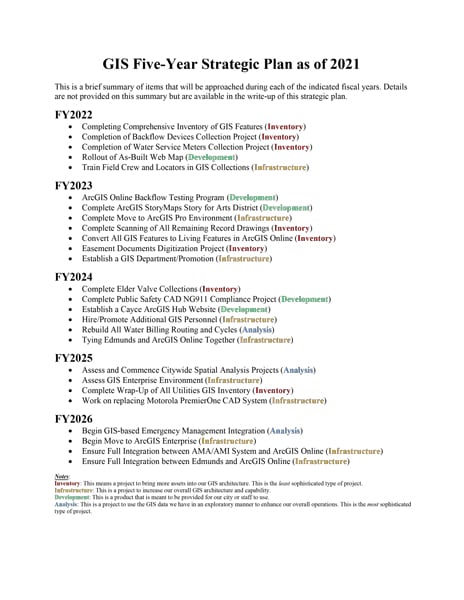In 2017, I was hired at the City of Cayce, South Carolina, to provide professional GIS support to the utilities department. At the time, Cayce—which has a population of about 14,000 people—had very little in the way of mature geotechnical capabilities. From virtually my first day on the job, I made it my mission to build a fundamental GIS architecture not just for utilities but also for the entire city. Along the way, I found that strategic planning was critical.
For some context: When I embarked on this journey, strategic planning as a management methodology was not something I had ever really focused on. I understood that I needed to do some manner of planning, but my methods were ad hoc. It wasn’t until I started putting together regular, year-end reports that I discovered how important it was to create a strategic plan.
About two years after I started working at Cayce, I realized that to advance our geospatial capabilities, I would need to justify additional expenditures and investments in GIS resources. My initial approach to this was to create a series of annual return on investment (ROI) reports. At the end of each year, I would present to management what I had accomplished, how much value and cost savings my activities had generated, and how much the city had paid for all this. To be prudent, I made limited requests for additional resources. I found, however, that my managers often didn’t understand why I needed the items I was requesting, nor did they comprehend how it would benefit them going forward.
To better explain all this to the city’s leadership, I developed a reporting system that I began presenting to my managers each year. It is composed of the following three elements:
- GIS presentations: By putting together periodic presentations to showcase the city’s GIS work, I have been able to educate stakeholders on the benefits that these activities are providing to Cayce. This also allows me to inform people about new technology and advances in GIS.
- An ROI analysis: The ROI analysis that I put together at the end of every year gives my direct managers quantitative evidence of what they’ve gained from GIS versus what it has cost. This not only justifies the city’s geospatial activities, but it also provides rationale for additional funding and resources.
- A strategic plan: By conducting an annual review of Cayce’s GIS strategic plan with my managers, I can show them how their investments in geospatial technology will be spent. This also gives them the opportunity to weigh in on the process.
Taken together, these three elements have been incredibly effective at the City of Cayce. In five years, we have gone from having one to two GIS users at the city and paying just a few hundred dollars annually for geospatial technology to having dozens of users across the organization and spending more than $100,000 per year on GIS-related activities.

Strategic planning was the last element I incorporated into this system. It has proven critical. Using our strategic plan, I have been able to construct a project-to-project workflow over the past few years. Each time we complete one of our planned projects, it gets added to the annual reports we prepare and becomes an immediately recognizable example of how GIS enhances operations at the city.
Our strategic plans are remarkably simple. I wonder if this is something that many people don’t realize—that a strategic plan doesn’t have to be an extensive, flashy product that takes a lot of time and effort to develop. Cayce’s GIS strategic plan boils down to a single page of bulleted text that describes what we would like to do. The plan is easy to read, comprehend, and update.
When I created our first strategic plan, I simply brainstormed a list of endeavors I wanted the city to pursue—some in the immediate term, some in the near future, and others further down the road. I then refined these ideas, concepts, and projects into a list of bullet points organized by priority. From there, I thought about the level of effort and resources each undertaking would require and sorted the items into what I felt could be accomplished over the course of a single year. After creating a series of lists going out five years, the leftover endeavors fell to the bottom of the page as wish list projects. I then wrote up detailed descriptions of each bullet point. The resultant documents became the city’s first GIS strategic plan.
For Cayce’s purposes, I have tended to focus near-term goals on less sophisticated and more fundamental projects, such as building out the city’s GIS infrastructure and managing geospatial inventory. I leave more advanced and exploratory projects—such as conducting major spatial analyses, expanding into new departments and fields, and advancing geospatial technology—for the longer term.
Something else that has been very useful is recognizing that iteration is important. I review and update our GIS strategic plan every year. I don’t regard any project as set in stone. While the plan is a good guidepost for me to understand how to develop and enhance Cayce’s GIS capabilities, I also want it to be flexible enough to take into account software and technological changes, system discoveries, and new developments within the city.
Taking the time to produce a GIS strategic plan provides great benefits to any organization. At Cayce, our strategic plan has become an effective road map for advancing the city’s geospatial architecture, technology, and undertakings. While we change and update it frequently, it still provides useful guidance. This plan has instilled confidence in my managers that I am moving in the right direction. When combined with giving periodic presentations about the work we do and the ROI analyses we put together at the end of each year, our strategic plan has become a very effective way to gain support for GIS at the city and garner recognition for what we do with the technology.
I would go so far as to say that putting together a GIS strategic plan is necessary for all mature enterprises. This ensures that the GIS they use can not only meet the challenges within their own organizations, but that it can also stand up to the demands that often crop up in this rapidly changing, technological field.


